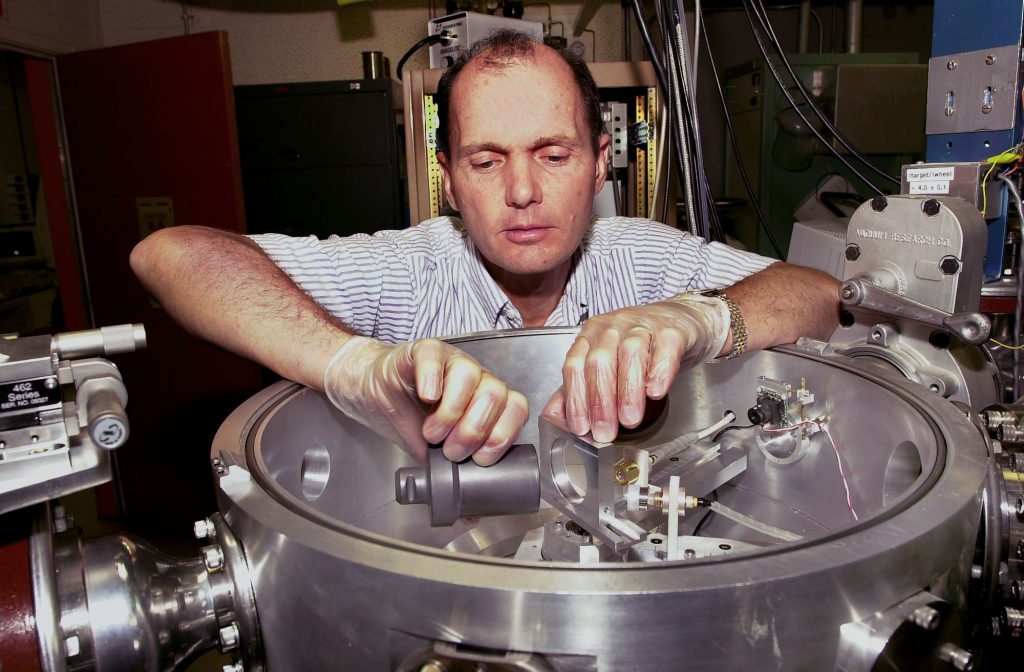
Download 300dpi JPEG image, ‘fusion.jpg’, 417K (Media are welcome to download/publish this image with related news stories.)
ALBUQUERQUE, N.M. — A research team from the Department of Energy’s (DOE) Sandia National Laboratories, General Atomics and the University of California at San Diego has resolved one of many issues impeding successful magnetic confinement fusion. The team discovered a way to keep the fusion plasma from eroding divertor walls inside tokamak fusion machines.
Divertor walls are the region in a tokamak where material surfaces are in direct contact with the energy-producing fusion plasma. Erosion is undesirable because it increases the need to replace components in the divertor, contaminates the plasma, and causes material depositions in undesirable places — all problematic for successful fusion.
The researchers used the DIII-D tokamak magnetic fusion machine at General Atomics in San Diego and the Divertor Materials Evaluation System (DiMES) to conduct experiments that showed erosion is eliminated during operation with detached plasmas. General Atomics operates the DIII-D fusion machine for DOE.
Fusion combines or fuses light atoms, such as atoms of hydrogen, to form heavier atoms. In the process some of the mass of hydrogen is converted into energy — the same way the sun creates energy. The goal is to convert this fusion energy into electric power.
While there are several ways to produce fusion, among the most promising is the tokamak, a large doughnut-shaped magnetic confinement device. “Tokamak” is an acronym derived from Russian words meaning “toroidal chamber and magnetic coil.”
Current — up to several million amps — flows through the doughnut-shaped plasma made of deuterium and tritium. A strong magnetic field confines plasma that high-energy particle beams or radio-frequency waves heat to more than a hundred million degrees Celsius. The hot plasma travels quickly parallel to the magnetic field, but slowly across the field toward the wall.
Plasma at the outer boundary flows into a separate chamber where it strikes the divertor surface and is neutralized. The divertor prevents plasma from striking and degrading the chamber walls and generating impurities that would cool and contaminate the main plasma. Constructed of graphite to survive high heat loads, the divertor can be eroded by hydrogen plasmas.
“Because today’s research fusion machines do not operate for long periods [typically less than 10 minutes a day], erosion has not been a significant problem,” says Bill Wampler, Sandia researcher studying divertor wall erosion. “But when we eventually have a fusion reactor working all the time, erosion will be a big issue.”
The DiMES research team included Wampler, Stuart Van Deusen and Bob Bastasz of Sandia, Dennis Whyte of the University of California at San Diego, and Clement Wong and Phil West of General Atomics. Simply put, the team showed that divertor erosion can be eliminated by causing plasmas to detach.
Detached divertor plasmas, which have been studied for several years as a method to spread power deposition over larger areas, result by injecting deuterium gas into the plasma in the divertor. The gas cools the plasma near the divertor surface but does not significantly cool the core plasma in the main chamber.
The lower temperature of the detached plasma at the divertor walls reduces the energy of hydrogen atoms and ions impinging on the divertor surface. These new experiments show erosion by “physical sputtering” (erosion process where incoming atoms have sufficient energy to knock atoms off a surface) is eliminated because the energy of particles hitting the material surface drops below the erosion threshold.
To determine this, the researchers exposed graphite cylinders and various metal films to divertor plasmas. The researchers measured erosion resulting from these exposures using ion-beam analysis. No erosion was detected with detached plasmas. In contrast, high erosion rates occurred for the normal “attached” divertor plasmas obtained without deuterium injection in the divertor.
Wong, the General Atomics researcher who is also chair of the Fusion Energy Division, American Nuclear Society, 1999-2000, says the joint nature of this research played an important role in its success.
“The significant results obtained by the DiMES program show very clearly the benefits of close collaboration between different technical disciplines and institutions,” Wong says.
But, says Wampler, more research is needed.
“We still have much more work to do, but our preliminary results show detached plasma operation provides an effective way to eliminate erosion in the divertor. We may have resolved a major problem in fusion,” Wampler says.
General Atomics, founded in 1955, is involved in high-technology nuclear energy, commercial, and defense-related research, development and manufacturing.